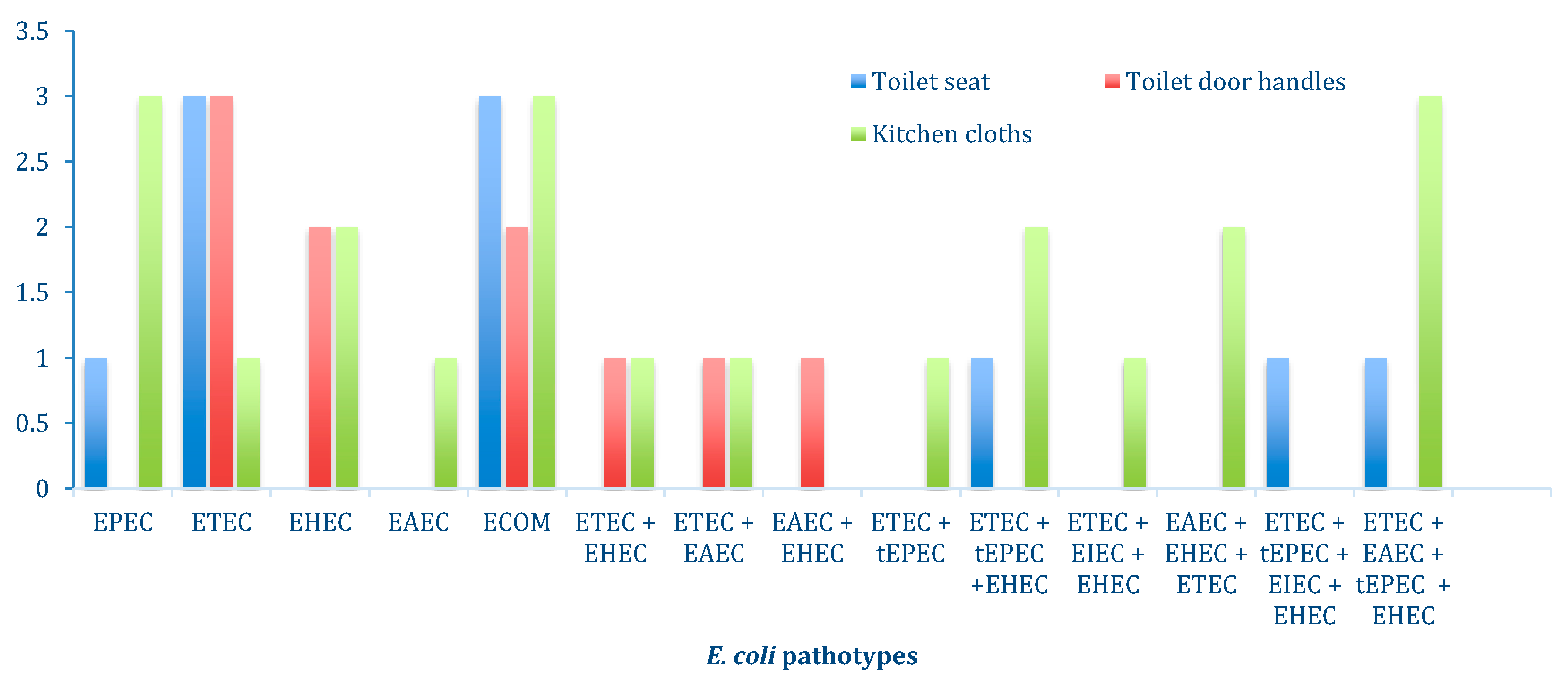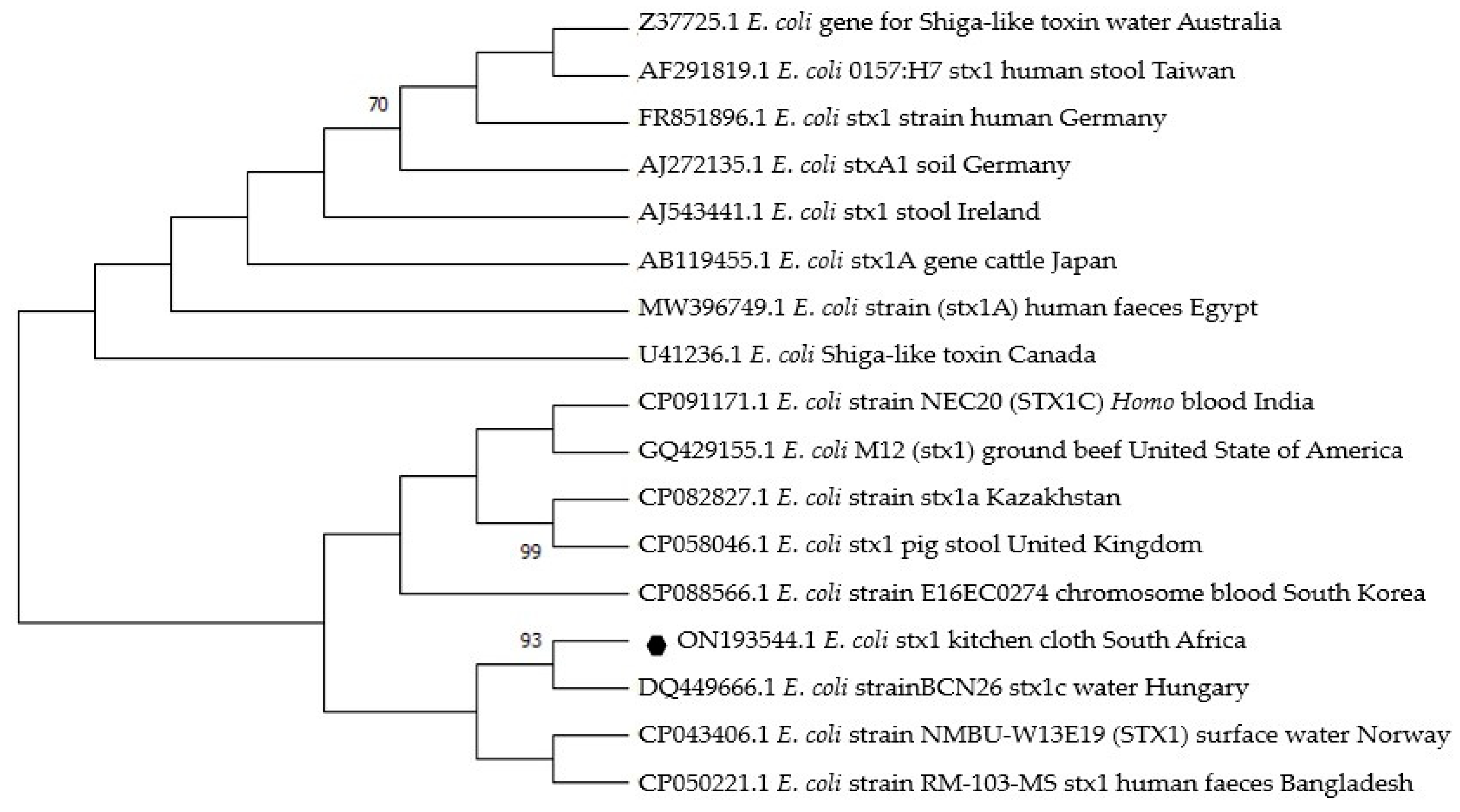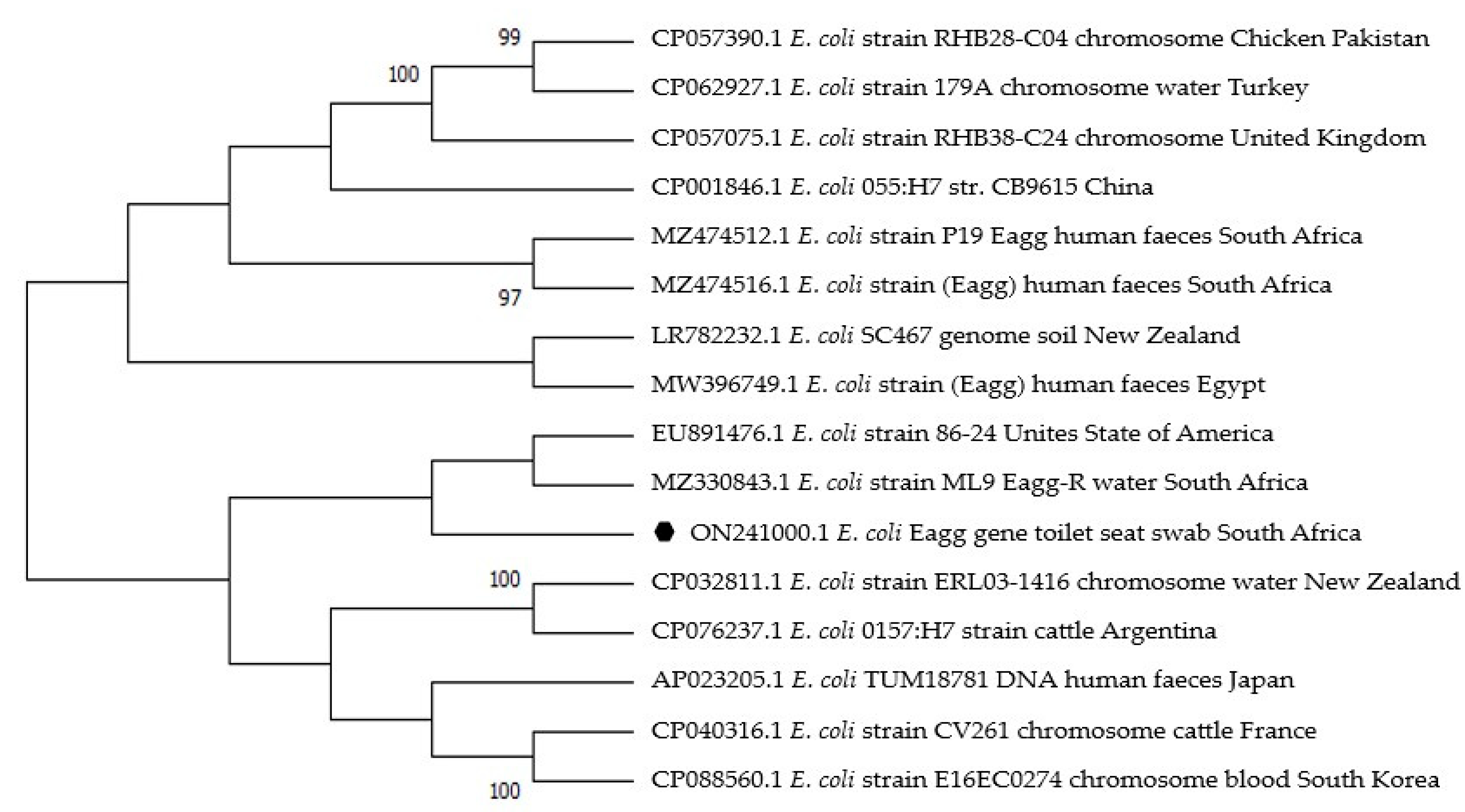Prevalence and Antimicrobial Resistance Profile of Diarrheagenic Escherichia coli from Fomites in Rural Households in South Africa
Abstract
1. Introduction
2. Methods and Materials
2.1. Study Area and Period
2.2. Ethics
2.3. Sample Collection
2.4. Bacterial Isolation and Identification
2.4.1. Bacterial Isolation
2.4.2. Bacterial Identification
2.5. Molecular Identification of E. coli Isolates
2.5.1. DNA Extraction
2.5.2. Genotypic Identification and Classification of E. coli Pathotypes
2.6. Sequencing and Phylogenetic Analysis
2.7. Determination of Antibiotic Susceptibility
3. Results
3.1. Study Characteristics
3.2. Prevalence of E. coli on Kitchen Cloths and Toilets
3.3. Characterization of E. coli Pathotypes
3.4. Antibiotic Resistance Profile of E. coli
3.5. Sequence and Phylogenetic Analysis
Sequence Analysis and Phylogenetic Analysis
4. Discussion
5. Conclusions
Supplementary Materials
Author Contributions
Funding
Institutional Review Board Statement
Informed Consent Statement
Data Availability Statement
Acknowledgments
Conflicts of Interest
References
- Keddy, K.H. Old and new challenges related to global burden of diarrhoea. Lancet Infect. Dis. 2018, 18, 1163–1164. [Google Scholar] [CrossRef]
- Das, R.; Palit, P.; Haque, M.A.; Ahmed, T.; Faruque, A.G. Association between Pathogenic Variants of Diarrheagenic Escherichia coli and Growth in Children under 5 Years of Age in the Global Enteric Multicenter Study. Am. J. Trop. Med. Hyg. 2022, 107, 72. [Google Scholar] [CrossRef] [PubMed]
- Stephens, B.; Azimi, P.; Thoemmes, M.S.; Heidarinejad, M.; Allen, J.G.; Gilbert, J.A. Microbial exchange via fomites and implications for human health. Curr. Pollut. Rep. 2019, 5, 198–213. [Google Scholar] [CrossRef]
- Katzenberger, R.H.; Rösel, A.; Vonberg, R.-P. Bacterial survival on inanimate surfaces: A field study. BMC Res. Notes 2021, 14, 97. [Google Scholar] [CrossRef]
- Van Elsas, J.D.; Semenov, A.V.; Costa, R.; Trevors, J.T. Survival of Escherichia coli in the environment: Fundamental and public health aspects. ISME J. 2011, 5, 173–183. [Google Scholar] [CrossRef] [PubMed]
- Alonge, O.; Auwal, B.; Aboh, M. Bacterial contamination of toilet door handles on Baze University campus Abuja Nigeria. Afr. J. Clin. Exp. Microbiol. 2019, 20, 35–41. [Google Scholar] [CrossRef]
- Nworie, A.; Ayeni, J.; Eze, U.; Azi, S. Bacterial contamination of door handles/knobs in selected public conveniences in Abuja metropolis, Nigeria: A public health threat. Cont. J. Med. Res. 2012, 6, 7–11. [Google Scholar]
- Kaur, R.; Singh, D.; Kesavan, A.K.; Kaur, R. Molecular characterization and antimicrobial susceptibility of bacterial isolates present in tap water of public toilets. Int. Health 2020, 12, 472–483. [Google Scholar] [CrossRef]
- Su, C.; Brandt, L.J. Escherichia coli O157: H7 infection in humans. Ann. Intern. Med. 1995, 123, 698–707. [Google Scholar] [CrossRef] [PubMed]
- Seidman, J.; Kanungo, R.; Bourgeois, A.; Coles, C. Risk factors for antibiotic-resistant E. coli in children in a rural area. Epidemiol. Infect. 2009, 137, 879–888. [Google Scholar] [CrossRef]
- Potgieter, N.; Aja-Okorie, U.; Mbedzi, R.L.; Traore-Hoffman, A.N. Bacterial contamination on household latrine surfaces: A case study in rural and Peri-urban communities in South Africa. In Current Microbiological Research in Africa: Selected Applications for Sustainable Environmental Management; Springer: Cham, Switzerland, 2020; pp. 175–183. [Google Scholar]
- Chavatte, N.; Baré, J.; Lambrecht, E.; Van Damme, I.; Vaerewijck, M.; Sabbe, K.; Houf, K. Co-occurrence of free-living protozoa and foodborne pathogens on dishcloths: Implications for food safety. Int. J. Food Microbiol. 2014, 191, 89–96. [Google Scholar] [CrossRef]
- Sharma, M.; Eastridge, J.; Mudd, C. Effective household disinfection methods of kitchen sponges. Food Control 2009, 20, 310–313. [Google Scholar] [CrossRef]
- Ugboko, H.U.; Nwinyi, O.C.; Oranusi, S.U.; Oyewale, J.O. Childhood diarrhoeal diseases in developing countries. Heliyon 2020, 6, e03690. [Google Scholar] [CrossRef]
- Keshav, V.; Kruger, C.A.; Mathee, A.; Naicker, N.; Swart, A.; Barnard, T.G. E. coli from dishcloths as an indicator of hygienic status in households. J. Water Sanit. Hyg. Dev. 2015, 5, 351–358. [Google Scholar] [CrossRef]
- Levine, M.M. Escherichia coli that cause diarrhea: Enterotoxigenic, enteropathogenic, enteroinvasive, enterohemorrhagic, and enteroadherent. J. Infect. Dis. 1987, 155, 377–389. [Google Scholar] [CrossRef] [PubMed]
- Modgil, V.; Mahindroo, J.; Narayan, C.; Kalia, M.; Yousuf, M.; Shahi, V.; Koundal, M.; Chaudhary, P.; Jain, R.; Sandha, K.S. Comparative analysis of virulence determinants, phylogroups, and antibiotic susceptibility patterns of typical versus atypical Enteroaggregative E. coli in India. PLOS Neglected Trop. Dis. 2020, 14, e0008769. [Google Scholar] [CrossRef] [PubMed]
- Nyholm, O.; Halkilahti, J.; Wiklund, G.; Okeke, U.; Paulin, L.; Auvinen, P.; Haukka, K.; Siitonen, A. Comparative genomics and characterization of hybrid Shigatoxigenic and enterotoxigenic Escherichia coli (STEC/ETEC) strains. PLoS ONE 2015, 10, e0135936. [Google Scholar] [CrossRef]
- Hazen, T.H.; Michalski, J.; Luo, Q.; Shetty, A.C.; Daugherty, S.C.; Fleckenstein, J.M.; Rasko, D.A. Comparative genomics and transcriptomics of Escherichia coli isolates carrying virulence factors of both enteropathogenic and enterotoxigenic E. coli. Sci. Rep. 2017, 7, 3513. [Google Scholar] [CrossRef]
- Bolukaoto, J.Y.; Singh, A.; Alfinete, N.; Barnard, T.G. Occurrence of hybrid diarrhoeagenic Escherichia coli associated with multidrug resistance in environmental water, Johannesburg, South Africa. Microorganisms 2021, 9, 2163. [Google Scholar] [CrossRef]
- Nguyen, T.V.; Le Van, P.; Le Huy, C.; Gia, K.N.; Weintraub, A. Detection and characterization of diarrheagenic Escherichia coli from young children in Hanoi, Vietnam. J. Clin. Microbiol. 2005, 43, 755–760. [Google Scholar] [CrossRef]
- Ledwaba, S.; Kabue, J.; Barnard, T.; Traore, A.; Potgieter, N. Enteric pathogen co-infections in the paediatric population from rural communities in the Vhembe District, South Africa. South Afr. J. Child Health 2018, 12, 170–174. [Google Scholar] [CrossRef]
- Beaber, J.W.; Hochhut, B.; Waldor, M.K. SOS response promotes horizontal dissemination of antibiotic resistance genes. Nature 2004, 427, 72–74. [Google Scholar] [CrossRef]
- Ochoa, T.J.; Ruiz, J.; Molina, M.; Del Valle, L.J.; Vargas, M.; Gil, A.I.; Ecker, L.; Barletta, F.; Hall, E.R.; Cleary, T.G. High frequency of antimicrobial resistance of diarrheagenic E. coli in Peruvian infants. Am. J. Trop. Med. Hyg. 2009, 81, 296. [Google Scholar] [CrossRef]
- Shigemura, K.; Yamashita, M.; Tanaka, K.; Arakawa, S.; Fujisawa, M.; Adachi, M. Chronological change of antibiotic use and antibiotic resistance in Escherichia coli causing urinary tract infections. J. Infect. Chemother. 2011, 17, 646–651. [Google Scholar] [CrossRef]
- Kapil, A. The challenge of antibiotic resistance: Need to contemplate. Indian J. Med. Res. 2005, 121, 83. [Google Scholar]
- Ventola, C.L. The antibiotic resistance crisis: Part 1: Causes and threats. Pharm. Ther. 2015, 40, 277. [Google Scholar]
- Scaletsky, I.C.; Souza, T.B.; Aranda, K.R.; Okeke, I.N. Genetic elements associated with antimicrobial resistance in enteropathogenic Escherichia coli (EPEC) from Brazil. BMC Microbiol. 2010, 10, 25. [Google Scholar] [CrossRef] [PubMed]
- Furlan, J.P.R.; Ramos, M.S.; Dos Santos, L.D.R.; da Silva Rosa, R.; Stehling, E.G. Multidrug-resistant Shiga toxin-producing Escherichia coli and hybrid pathogenic strains of bovine origin. Vet. Res. Commun. 2023, 1–7. [Google Scholar] [CrossRef] [PubMed]
- Wilkinson, M.; du Tout, A.; Mashimbye, D.; Cooligen, S. Assessment of Handwashing and Hand Hygiene Behaviour; Water Research Commission: Pretoria, South Africa, 2012. [Google Scholar]
- Vhembe. Vhembe District Municipality 2021/22 IDP Review; Vhembe District. 2022; pp. 88–89. Available online: http://www.vhembe.gov.za/media/content/documents/2021/2025/o_2021f2087kkc2021almpu2072g2022j2021l2027s2023vh2022k.pdf?filename=2021%202022%202020IDP%202020REVIEW.pdf (accessed on 3 August 2023).
- Hurst, C.J.; Crawford, R.L.; Garland, J.L.; Lipson, D.A. Manual of Environmental Microbiology; American Society for Microbiology Press: Washington, DC, USA, 2007. [Google Scholar]
- Nkiwane, L.; Chigo, T. Microbial Analysis of Woven Cotton Kitchen Towels. Zimb. J. Sci. Technol. 2014, 9, 47–58. [Google Scholar]
- Lehman, D. Triple Sugar Iron Agar Protocols; American Society for Microbiology: Washington, DC, USA, 2005; pp. 1–7. [Google Scholar]
- Alam, M.; Nahar, S.; Chowdhury, M.; Hasan, M.; Islam, M.; Sikdar, B. Biochemical characterization of bacteria responsible for bacterial black pit disease of lime (Citrus aurantifolia) and their control system. Eur. J. Biotechnol. Biosci. 2019, 7, 16–22. [Google Scholar]
- Omar, K.; Potgieter, N.; Barnard, T. Development of a rapid screening method for the detection of pathogenic Escherichia coli using a combination of Colilert® Quanti-Trays/2000 and PCR. Water Sci. Technol. Water Supply 2010, 10, 7–13. [Google Scholar] [CrossRef]
- Barnard, T.; Robertson, C.; Jagals, P.; Potgieter, N. A rapid and low-cost DNA extraction method for isolating Escherichia coli DNA from animal stools. Afr. J. Biotechnol. 2011, 10, 1485–1490. [Google Scholar]
- Boom, R.; Sol, C.; Salimans, M.; Jansen, C.; Wertheim-van Dillen, P.; Van der Noordaa, J. Rapid and simple method for purification of nucleic acids. J. Clin. Microbiol. 1990, 28, 495–503. [Google Scholar] [CrossRef] [PubMed]
- Alfinete, N.W.; Bolukaoto, J.Y.; Heine, L.; Potgieter, N.; Barnard, T.G. Virulence and phylogenetic analysis of enteric pathogenic Escherichia coli isolated from children with diarrhoea in South Africa. Int. J. Infect. Dis. 2022, 114, 226–232. [Google Scholar] [CrossRef]
- Omar, K.; Barnard, T. Detection of diarrhoeagenic Escherichia coli in clinical and environmental water sources in South Africa using single-step 11-gene m-PCR. World J. Microbiol. Biotechnol. 2014, 30, 2663–2671. [Google Scholar] [CrossRef]
- Pass, M.; Odedra, R.; Batt, R. Multiplex PCRs for identification of Escherichia coli virulence genes. J. Clin. Microbiol. 2000, 38, 2001–2004. [Google Scholar] [CrossRef] [PubMed]
- Aranda, K.R.S.; Fagundes-Neto, U.; Scaletsky, I.C.A. Evaluation of multiplex PCRs for diagnosis of infection with diarrheagenic Escherichia coli and Shigella spp. J. Clin. Microbiol. 2004, 42, 5849–5853. [Google Scholar] [CrossRef]
- Moses, A.; Garbati, M.; Egwu, A.; Ameh, E. Detection of E. coli 0157 and 026 serogroups in human immunodeficiency virus-infected patients with clinical manifestation of diarrhoea in Maiduguri, Nigeria. Res. J. Med. Med. Sci. 2006, 1, 140–145. [Google Scholar]
- Kimata, K.; Shima, T.; Shimizu, M.; Tanaka, D.; Isobe, J.; Gyobu, Y.; Watahiki, M.; Nagai, Y. Rapid categorization of pathogenic Escherichia coli by multiplex PCR. Microbiol. Immunol. 2005, 49, 485–492. [Google Scholar] [CrossRef]
- Mbene, A.B.; Houreld, N.N.; Abrahamse, H. DNA damage after phototherapy in wounded fibroblast cells irradiated with 16 J/cm2. J. Photochem. Photobiol. B: Biol. 2009, 94, 131–137. [Google Scholar] [CrossRef]
- Bauer, A.; Kirby, W.; Sherris, J.C.; Turck, M. Antibiotic susceptibility testing by a standardized single disk method. Am. J. Clin. Pathol. 1966, 45, 493–496. [Google Scholar] [CrossRef]
- Hudzicki, J. Kirby-Bauer disk diffusion susceptibility test protocol. Am. Soc. Microbiol. 2009, 15, 55–63. [Google Scholar]
- Natarajan, M.; Kumar, D.; Mandal, J.; Biswal, N.; Stephen, S. A study of virulence and antimicrobial resistance pattern in diarrhoeagenic Escherichia coli isolated from diarrhoeal stool specimens from children and adults in a tertiary hospital, Puducherry, India. J. Health Popul. Nutr. 2018, 37, 17. [Google Scholar] [CrossRef]
- Sibiya, J.E.; Gumbo, J.R. Knowledge, attitude and practices (KAP) survey on water, sanitation and hygiene in selected schools in Vhembe District, Limpopo, South Africa. Int. J. Environ. Res. Public Health 2013, 10, 2282–2295. [Google Scholar] [CrossRef] [PubMed]
- Borchgrevink, C.P.; Cha, J.; Kim, S. Hand washing practices in a college town environment. J. Environ. Health 2013, 75, 18–25. [Google Scholar]
- Speirs, J.; Anderton, A.; Anderson, J. A study of the microbial content of the domestic kitchen. Int. J. Environ. Health Res. 1995, 5, 109–122. [Google Scholar] [CrossRef]
- Barker, J.; Bloomfield, S. Survival of Salmonella in bathrooms and toilets in domestic homes following salmonellosis. J. Appl. Microbiol. 2000, 89, 137–144. [Google Scholar] [CrossRef]
- McGinnis, S.; Marini, D.; Amatya, P.; Murphy, H.M. Bacterial contamination on latrine surfaces in community and household latrines in Kathmandu, Nepal. Int. J. Environ. Res. Public Health 2019, 16, 257. [Google Scholar] [CrossRef] [PubMed]
- Ngonda, F. Assessment of bacterial contamination of toilets and bathroom doors handle/knobs at Daeyang Luke hospital. Pharm. Biol. Eval. 2017, 4, 193–197. [Google Scholar] [CrossRef]
- Maori, L.; Agbor, V.O.; Ahmed, W.A. The prevalence of bacterial organisms on toilet door handles in Secondary Schools in Bokkos LGA, Jos, Plateau Sate, Nigeria. IOSR J. Pharm. Biol. Sci. 2013, 8, 85–91. [Google Scholar]
- van Pelt-Verkuil, E.; van Belkum, A.; Hays, J.P. Ensuring PCR quality–laboratory organisation, PCR optimization and controls. In Principles and Technical Aspects of PCR Amplification; Springer: Dordrecht, The Netherlands, 2008; pp. 183–212. [Google Scholar]
- Banda, N.T. Characterization of E. coli Strains from Rural Communities in the Vhembe District (Limpopo South Africa). Ph.D. Thesis, University of Venda, Tohoyandu, South Africa, 2019. [Google Scholar]
- Lindstedt, B.-A.; Finton, M.D.; Porcellato, D.; Brandal, L.T. High frequency of hybrid Escherichia coli strains with combined Intestinal Pathogenic Escherichia coli (IPEC) and Extraintestinal Pathogenic Escherichia coli (ExPEC) virulence factors isolated from human faecal samples. BMC Infect. Dis. 2018, 18, 544. [Google Scholar] [CrossRef]
- Borgatta, B.; Kmet-Lunaček, N.; Rello, J. E. coli O104: H4 outbreak and haemolytic–uraemic syndrome. Med. Intensiv. (Engl. Ed.) 2012, 36, 576–583. [Google Scholar] [CrossRef][Green Version]
- Mare, I.; Coetzee, J. The incidence of transmissible drug resistance factors among strains of Escherichia coli in the Pretoria area. S. Afr. Med. J. 1966, 40, 980–981. [Google Scholar] [PubMed]
- Chiyangi, H.; Muma, J.B.; Malama, S.; Manyahi, J.; Abade, A.; Kwenda, G.; Matee, M.I. Identification and antimicrobial resistance patterns of bacterial enteropathogens from children aged 0–59 months at the University Teaching Hospital, Lusaka, Zambia: A prospective cross sectional study. BMC Infect. Dis. 2017, 17, 117. [Google Scholar] [CrossRef] [PubMed]
- Balogun, S.; Ojo, O.; Bayode, O.; Kareem, S. High level detection of extended spectrum beta-lactamase gene encoding Enterobacteriaceae in public toilets in Abeokuta, Nigeria. Ceylon J. Sci. 2020, 49, 165–172. [Google Scholar] [CrossRef]
- Mirsoleymani, S.R.; Salimi, M.; Shareghi Brojeni, M.; Ranjbar, M.; Mehtarpoor, M. Bacterial pathogens and antimicrobial resistance patterns in pediatric urinary tract infections: A four-year surveillance study (2009–2012). Int. J. Pediatr. 2014, 2014, 126142. [Google Scholar] [CrossRef]
- Lamprecht, C.; Romanis, M.; Huisamen, N.; Carinus, A.; Schoeman, N.; Sigge, G.O.; Britz, T.J. Escherichia coli with virulence factors and multidrug resistance in the Plankenburg River. S. Afr. J. Sci. 2014, 110, 01–06. [Google Scholar] [CrossRef]
- Ojima, M.; Toshima, Y.; Koya, E.; Ara, K.; Tokuda, H.; Kawai, S.; Kasuga, F.; Ueda, N. Hygiene measures considering actual distributions of microorganisms in Japanese households. J. Appl. Microbiol. 2002, 93, 800–809. [Google Scholar] [CrossRef]
- Bielaszewska, M.; Karch, H. Non-O157: H7 Shiga toxin (verocytotoxin)-producing Escherichia coli strains: Epidemiological significance and microbiological diagnosis. World J. Microbiol. Biotechnol. 2000, 16, 711–718. [Google Scholar] [CrossRef]
- Friedrich, A.; Bielaszewska, M.; Karch, H. Diagnosis of Shiga Toxin-Producing Escherichia coli Infections/Die Diagnostik von Shiga Toxin-produzierenden Escherichia coli-Infektionen. LaboratoriumsMedizin 2002, 26, 183–190. [Google Scholar] [CrossRef]
- Wieler, L.H.; Semmler, T.; Eichhorn, I.; Antao, E.M.; Kinnemann, B.; Geue, L.; Karch, H.; Guenther, S.; Bethe, A. No evidence of the Shiga toxin-producing E. coli O104: H4 outbreak strain or enteroaggregative E. coli (EAEC) found in cattle faeces in northern Germany, the hotspot of the 2011 HUS outbreak area. Gut Pathog. 2011, 3, 17. [Google Scholar] [CrossRef] [PubMed]
- Escobar-Páramo, P.; Clermont, O.; Blanc-Potard, A.-B.; Bui, H.; Le Bouguénec, C.; Denamur, E. A specific genetic background is required for acquisition and expression of virulence factors in Escherichia coli. Mol. Biol. Evol. 2004, 21, 1085–1094. [Google Scholar] [CrossRef] [PubMed]
- Riley, L.W.; Remis, R.S.; Helgerson, S.D.; McGee, H.B.; Wells, J.G.; Davis, B.R.; Hebert, R.J.; Olcott, E.S.; Johnson, L.M.; Hargrett, N.T. Hemorrhagic colitis associated with a rare Escherichia coli serotype. N. Engl. J. Med. 1983, 308, 681–685. [Google Scholar] [CrossRef] [PubMed]
- Aijuka, M.; Santiago, A.E.; Girόn, J.A.; Nataro, J.P.; Buys, E.M. Enteroaggregative Escherichia coli is the predominant diarrheagenic E. coli pathotype among irrigation water and food sources in South Africa. Int. J. Food Microbiol. 2018, 278, 44–51. [Google Scholar] [CrossRef]
- Van Der Hooft, J.J.; Goldstone, R.J.; Harris, S.; Burgess, K.E.; Smith, D.G. Substantial extracellular metabolic differences found between phylogenetically closely related probiotic and pathogenic strains of Escherichia coli. Front. Microbiol. 2019, 19, 252. [Google Scholar] [CrossRef]
- Isaäcson, M.; Canter, P.H.; Effler, P.; Arntzen, L.; Bomans, P.; Heenan, R. Haemorrhagic colitis epidemic in Africa. Lancet 1993, 341, 961. [Google Scholar] [CrossRef]




| Pathogen | Primers | Sequence (5′-3′) | Size (bp) | Conc. (µM) | Reference |
|---|---|---|---|---|---|
| E. coli | mdh (F) | GGT ATG GAT CGT TCC GAC CT | 300 | 0.1 | Omar et al. [40] |
| Mdh(R) | GGC AGA ATG GTA ACA CCA GAG | ||||
| EIEC | ial (F) | GGT ATG ATG ATG AGT CCA | 630 | 0.2 | Pass et al. [41] |
| ial (R) | GGA GGC CAA CAA TTA TTT CC | ||||
| EHEC/Atypical EPEC | eaeA (F) | GGT ATG ATG ATG ATG AGT CCA | 917 | 0.3 | Aranda et al. [42] |
| eaeA(R) | GGA GGC CAA CAA TTA TTT CC | ||||
| Typical EPEC | bfpA (F) | AAT GGT GCT TGC GCT TGC TGC | 410 | ||
| EAEC | eagg (F) | AGA CTC TGG CGA AAG ACT GTA TC | 194 | 0.2 | Pass et al. [41] |
| Eagg(R) | ATG GCT GTC TGT AAT AGA TGA GAA C | ||||
| EHEC | stx1 (F) | ACA CTG GAT GAT CTC AGT GG | 614 | 0.5 | Moses et al. [43] |
| stx1(R) | CTG AAT CCC CCT CCA TTA TG | ||||
| stx2 (F) | CCA TGA CAA CGG ACA GCA GTT | 779 | 0.3 | ||
| Stx2(R) | CCT GTC AAC TGA GCA CTT TG | ||||
| ETEC | lt (F) | GGC GAC AGA TTA TAC CGT GC | 330 | 0.1 | Pass et al. [41] |
| lt (R) | CGG TCT CTA TAT TCC CTG TT | ||||
| st (F) | TTT CCC CTC TTT TAG TCA GTC AAC TG | 160 | 0.5 | ||
| st (R) | GGC AGG ATT ACA ACA AAG TTC ACA | ||||
| E. coli toxin | astA (F) | GCC ATC AAC ACA GTA TAT CC | 106 | 0.3 | Kimata et al. [44] |
| astA (R) | GAG TGA CGG CTT TGT AGT C | ||||
| External Control | gapdh (F) | GAG TCA ACG GAT TTG GTC GT | 238 | 0.1 | Mbene et al. [45] |
| gapdh (R) | TTG ATT TTG GAG GGA TCT CG |
| Antibiotics | Disc Code | Disc Potency (µg) | Inhibition Zone (mm) | ||
|---|---|---|---|---|---|
| Resistant | Intermediate | Sensitive | |||
| Amoxicillin-Clavulanic | AMC | 30 | ≤19 | - | ≥20 |
| Azithromycin | AMZ | 30 | ≤13 | 17–19 | ≥20 |
| Chloramphenicol | CN | 30 | ≤12 | 13–17 | ≥18 |
| Gentamicin | GM | 10 | ≤12 | 13–14 | ≥15 |
| Ampicillin | AMP | 10 | ≤13 | 14–16 | ≥17 |
| Rifampicin | C | 5 | ≤16 | 17–19 | ≥20 |
| Tetracycline | TE | 5 | ≤11 | 12–14 | ≥15 |
| Penicillin | P | 10 | ≤14 | 15–20 | ≥21 |
| Variables | Category | Total Study Population (%) (n = 35) |
|---|---|---|
| Number of people in a household | One | 3 (8.6) |
| Two | 7 (20) | |
| More than two | 25 (71.4) | |
| Source of Water | Tap | 33 (94.3) |
| Well | 0 | |
| Surface | 2 (5.7) | |
| Handwashing means after using the toilet | Water only | 17 (49) |
| Water and soap | 15 (43) | |
| Do not wash | 3 (8.6) | |
| Type of toilet | Ventilated improved latrine | 27 (77.90) |
| Pit latrines | 1 (2.9) | |
| Flush toilets | 7 (20) | |
| Toilet condition | Clean | 16 (45.7) |
| Dirty | 19 (54.3) | |
| Sharing of the toilet with neighbors | Yes | 2 (5.7) |
| No | 33 (94.3) | |
| Animal ownership | Yes | 29 (83) |
| No | 6 (17) | |
| Animals are allowed to enter the house | Yes | 1 (2.9) |
| No | 34 (97.1) | |
| Diarrhea in the household | Yes | 4 (11.4) |
| No | 31 (88.6) | |
| Condition of kitchen cloth | Clean | 16 (45.7) |
| Dirty | 19 (54.3) | |
| Kitchen cloth use | Wiping up spills | 2 (5.7) |
| Drying hands | 2 (5.7) | |
| Covering food | 3 (8.6) | |
| Cleaning and drying up dishes | 7 (20) | |
| Multi-use | 21 (60) | |
| Washing soap | Powdered soap | 25 (71.4) |
| Bar soap | 6 (17) | |
| Jik bleach | 4 (11.4) |
| Samples | E. coli | Percentage (%) |
|---|---|---|
| Kitchen cloths; n = 35 | 25 | 71.4 |
| Toilet seats; n = 35 | 12 | 34.3 |
| Toilet door handles; n = 35 | 12 | 34.3 |
| Total; n = 105 | 49 | 46.7 |
| Resistance to Specific Antibiotic | Kitchen Cloths (51%) n = 25 | Toilet Seats (24.5%) n = 12 | Toilet Door Handles (24.5%) n = 12 | Total (%) n = 49 |
|---|---|---|---|---|
| Ampicillin | 25 (100) | 12 (100) | 12 (100) | 49 (100) |
| Tetracycline | 4 (16) | 1 (8.3) | 0 | 5 (24.3) |
| Amoxicillin | 25 (100) | 12 (100) | 12 (100) | 49 (100) |
| Chloramphenicol | 5 (20) | 2 (16.6) | 0 | 7 (36.6) |
| Rifampicin | 3 (12) | 0 | 0 | 3 (12) |
| Azithromycin | 0 | 0 | 0 | 0 |
| Gentamycin | 0 | 0 | 0 | 0 |
| Penicillin | 19 (76) | 7 (58.3) | 9 (75) | 35 (71.42) |
| Ampicillin and Amoxicillin | 25 (100) | 12 (100) | 12 (100) | 49 (100) |
| Ampicillin, Amoxicillin, and penicillin | 19 (76) | 7 (58.3) | 9 (75) | 35 (71.4) |
| Multidrug resistance Amoxicillin, Ampicillin, Penicillin, Chloramphenicol, and Tetracycline | 2 (8) | 1 (4) | 0 | 3 (6.1) |
Disclaimer/Publisher’s Note: The statements, opinions and data contained in all publications are solely those of the individual author(s) and contributor(s) and not of MDPI and/or the editor(s). MDPI and/or the editor(s) disclaim responsibility for any injury to people or property resulting from any ideas, methods, instructions or products referred to in the content. |
© 2023 by the authors. Licensee MDPI, Basel, Switzerland. This article is an open access article distributed under the terms and conditions of the Creative Commons Attribution (CC BY) license (https://creativecommons.org/licenses/by/4.0/).
Share and Cite
Rakhalaru, P.; Munzhedzi, L.; Abia, A.L.K.; Kabue, J.P.; Potgieter, N.; Traore, A.N. Prevalence and Antimicrobial Resistance Profile of Diarrheagenic Escherichia coli from Fomites in Rural Households in South Africa. Antibiotics 2023, 12, 1345. https://doi.org/10.3390/antibiotics12081345
Rakhalaru P, Munzhedzi L, Abia ALK, Kabue JP, Potgieter N, Traore AN. Prevalence and Antimicrobial Resistance Profile of Diarrheagenic Escherichia coli from Fomites in Rural Households in South Africa. Antibiotics. 2023; 12(8):1345. https://doi.org/10.3390/antibiotics12081345
Chicago/Turabian StyleRakhalaru, Phathutshedzo, Lutendo Munzhedzi, Akebe Luther King Abia, Jean Pierre Kabue, Natasha Potgieter, and Afsatou Ndama Traore. 2023. "Prevalence and Antimicrobial Resistance Profile of Diarrheagenic Escherichia coli from Fomites in Rural Households in South Africa" Antibiotics 12, no. 8: 1345. https://doi.org/10.3390/antibiotics12081345
APA StyleRakhalaru, P., Munzhedzi, L., Abia, A. L. K., Kabue, J. P., Potgieter, N., & Traore, A. N. (2023). Prevalence and Antimicrobial Resistance Profile of Diarrheagenic Escherichia coli from Fomites in Rural Households in South Africa. Antibiotics, 12(8), 1345. https://doi.org/10.3390/antibiotics12081345







